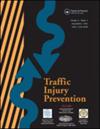Investigation of pre-crash avoidance kinematics in pedestrians of different ages through volunteer experiment and scaling methodology
IF 1.9
3区 工程技术
Q3 PUBLIC, ENVIRONMENTAL & OCCUPATIONAL HEALTH
引用次数: 0
Abstract
Objective
Understanding pedestrians’ pre-crash avoidance kinematics is crucial for improving the identification of potential collision areas in interactions with highly automated vehicles (HAVs). Age significantly influences pedestrian avoidance velocity and the subsequent crash risks. However, current active safety systems in HAVs often overlook the influence of pedestrians’ avoidance velocity and age on imminent accidents. This study analyzes how age affects pedestrian avoidance velocity and explores the incorporation of these factors in pre-crash scenarios to identify potential collision areas between pedestrians and vehicles.
Methods
Due to the infeasibility of measuring pedestrian avoidance behaviors in real-world pre-crash scenarios, we designed an indoor experimental platform replicating emergency crossroad scenarios to prompt subjects to mimic avoidance behaviors. 7 young and 7 middle-aged subjects participated in the experiment, resulting in a collection of 306 forward-avoidance, 297 backward-avoidance, and 42 normal-walking posture sequences. We developed a scaling approach integrating pedestrian kinematics and muscle physiology to establish a velocity-mapping relationship between young and middle-aged groups. Finally, we proposed an identification method for potential collision areas that considers pedestrians’ age and avoidance velocity.
Results
Middle-aged subjects required more time for natural avoidance actions averaging 0.15 s for forward and 0.25 s for backward avoidance, compared to their younger counterparts. While the forward avoidance velocity of the middle-aged subjects exhibited an average decrease of 0.3 m/s compared to young subjects, their backward avoidance velocity remained nearly identical. Overall, middle-aged subjects have a larger potential collision area than young participants. Pedestrians who actively avoid vehicles have a smaller potential collision area compared to those who remain normal walking.
Conclusions
We developed an indoor simulated pre-crash scenario experiment and a scaling approach to reveal the correlation between pedestrian avoidance velocity and age. This method can be further applied to obtain the avoidance velocity of elderly pedestrians. Additionally, we validate the effect of these factors in assessing potential collision areas. The decrease in avoidance velocity highlights a larger potential collision area for middle-aged pedestrians when interacting with vehicles. Such facts and data shall be appropriately considered in developing intelligent protection systems for pedestrians.
通过志愿者实验和缩放方法研究不同年龄段行人碰撞前的避让运动学。
目的:了解行人在碰撞前的避让运动学,对于改进识别与高度自动驾驶车辆(HAV)交互时的潜在碰撞区域至关重要。年龄在很大程度上影响着行人的避让速度和随后的碰撞风险。然而,目前无人驾驶汽车的主动安全系统往往忽略了行人的避让速度和年龄对即将发生的事故的影响。本研究分析了年龄对行人避让速度的影响,并探讨了将这些因素纳入碰撞前情景,以识别行人与车辆之间的潜在碰撞区域:由于不可能在真实世界的碰撞前场景中测量行人的避让行为,我们设计了一个复制紧急十字路口场景的室内实验平台,以促使受试者模仿避让行为。7 名年轻受试者和 7 名中年受试者参加了实验,共收集了 306 个向前避让、297 个向后避让和 42 个正常行走姿势序列。我们开发了一种结合行人运动学和肌肉生理学的缩放方法,以建立青年组和中年组之间的速度映射关系。最后,我们提出了一种考虑行人年龄和避让速度的潜在碰撞区域识别方法:结果:与年轻受试者相比,中年受试者的自然避让动作需要更多时间,前向避让平均需要 0.15 秒,后向避让平均需要 0.25 秒。虽然中年受试者的前向回避速度比年轻受试者平均降低了 0.3 米/秒,但他们的后向回避速度几乎保持一致。总体而言,中年受试者的潜在碰撞区域大于年轻受试者。与保持正常行走的行人相比,主动避开车辆的行人的潜在碰撞区域更小:我们开发了一种室内模拟碰撞前情景实验和缩放方法,以揭示行人避让速度与年龄之间的相关性。这种方法可进一步用于获取老年行人的避让速度。此外,我们还验证了这些因素对评估潜在碰撞区域的影响。避让速度的降低凸显了中年行人在与车辆发生碰撞时的潜在碰撞区域更大。在开发行人智能保护系统时,应适当考虑这些事实和数据。
本文章由计算机程序翻译,如有差异,请以英文原文为准。
求助全文
约1分钟内获得全文
求助全文
来源期刊

Traffic Injury Prevention
PUBLIC, ENVIRONMENTAL & OCCUPATIONAL HEALTH-
CiteScore
3.60
自引率
10.00%
发文量
137
审稿时长
3 months
期刊介绍:
The purpose of Traffic Injury Prevention is to bridge the disciplines of medicine, engineering, public health and traffic safety in order to foster the science of traffic injury prevention. The archival journal focuses on research, interventions and evaluations within the areas of traffic safety, crash causation, injury prevention and treatment.
General topics within the journal''s scope are driver behavior, road infrastructure, emerging crash avoidance technologies, crash and injury epidemiology, alcohol and drugs, impact injury biomechanics, vehicle crashworthiness, occupant restraints, pedestrian safety, evaluation of interventions, economic consequences and emergency and clinical care with specific application to traffic injury prevention. The journal includes full length papers, review articles, case studies, brief technical notes and commentaries.
 求助内容:
求助内容: 应助结果提醒方式:
应助结果提醒方式:


